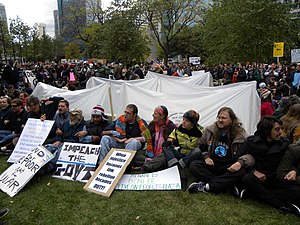| Occupy Minneapolis [OccupyMN] | |||
|---|---|---|---|
| Part of the Occupy Movement | |||
 Occupy Minneapolis protesters link arms, surrounding tents set up on October 15, 2011 at Hennepin County Government Center | |||
| Date | October 7, 2011 – ongoing (4748 days) | ||
| Location | |||
| Caused by | |||
| Methods | |||
| Status | Ongoing | ||
| Parties | |||
| |||
| Lead figures | |||
| |||
Occupy Minneapolis (OccupyMN) is a grassroots collaboration that began in October 2011 with a series of demonstrations in Minneapolis, Minnesota. Protesters have staged numerous occupations, most notably of the Hennepin County Government Center plaza.
Occupy Minneapolis is allied with New York City's Occupy Wall Street and is part of the global Occupy movement. The main issues that organizers seek to address are social and economic inequality, greed, corruption and the undue influence of corporations on government. Occupy Minneapolis protesters engage in direct action and use consensus decision-making in their general assemblies.
Occupy Minneapolis began as a protest encampment at Hennepin County Government Center plaza on October 7, 2011, renaming the site "The People's Plaza". It was eventually cleared out by law enforcement agencies after members of the Hennepin County Board chose to create new rules restricting the use of the public plaza.[1] As a result, police began to selectively enforce these rules and issue trespass orders against those who were found in violation of them.[2]
As a part of the Occupy Homes movement, Minneapolis activists coordinated the occupation of homes threatened with foreclosure by US Bank and Bank of America, successfully preventing evictions and securing loan modifications.
In early 2012, activists from Occupy Minneapolis helped establish the Paper Revolution Collective which is a decentralized global network of individuals who work to educate communities and promote conscious initiatives to preserve and restore both humanity and the earth. The collective continues to exist today and is composed of various cells which act independently in pursuit of a freer and more joyous world. They help coordinate and organize events around the planet to inspire change.[3]
In Spring 2012, protesters set up dual occupations of Peavey Plaza and Loring Park in downtown Minneapolis. Organizers and activists were told that they could erect tents for the use of storage during the resurgence. Late in the day of the reoccupation police communicated to protesters that they were planning to selectively enforce ordinances derived from the Minneapolis City Attorney's office stating that protesters and their equipment were interfering with, and blocking the public right of way. This selectively enforced local ordinance led to an escalation that resulted in both arrests, and the excessive use of force by the Minneapolis Police Department.[4]
Occupy Minneapolis continued to engage in organized meetings, events and actions throughout the summer of 2014, with their emphasis shifting away from occupations of public spaces and towards addressing the foreclosure crisis through the Occupy Homes movement.[5] along with creating active support networks for other locally-based movements and issues.
- ^ "Hennepin County Board OKs Occupy MN rules for plaza". Retrieved 2017-05-08.
- ^ "Occupy Minnesota protester gets $15K in trespass lawsuit". Star Tribune. Retrieved 2017-05-08.
- ^ "About – Paper Revolution". Paper Revolution. Retrieved 2017-05-08.
- ^ Chapman, Reg (8 April 2012). "After Saturday's Arrests, OccupyMN Is Looking For Place To Occupy". Retrieved 2017-05-08.
- ^ "Occupy Minneapolis – Events". Occupyminneapolis.mn. Retrieved June 20, 2012.